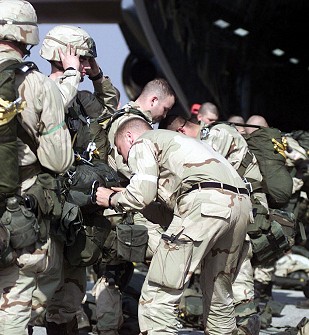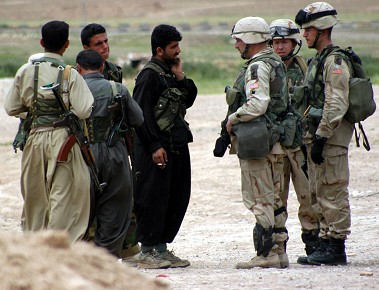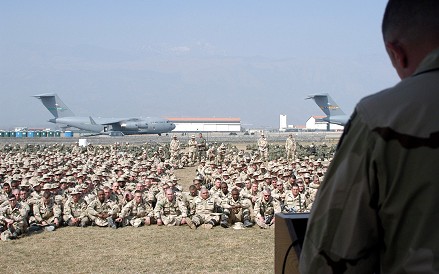Paratroopers
remember the jump into Iraq
Story by
Spc. Adrian Schulte, SETAF Public Affairs
|

Photo by Spc. C. Terrell Turner
|
| Last
minute checks are accomplished before paratroopers board the
plane bound for Iraq to participate in the historic jump.
|
VICENZA, Italy -- It
has almost been a year since about one thousand paratroopers of the
173rd Airborne Brigade parachuted into war, opening up the northern
front in the effort to liberate Iraq. The March 26, 2003 jump was
recently classified as a combat jump and the paratroopers who
participated in it will now be able to stick their chests out with
pride showing off the gold star, or “mustard stain,” that crowns
their parachutist wings.
So what is it like to jump into war?
Those troops, young and old, went through an extraordinary
experience, one that many paratroopers can only dream of. Many of
the Soldiers had been jumping for years, but for others, this would
be their first jump after airborne school.
“I knew it was real when they gave
us live ammo at the airfield. I knew then that there was no turning
back,” recalled Pfc. Jerry Allen, Chosen Co. 2nd Battalion, 503rd
Infantry (Airborne). “I’ve never seen so many planes in my
life,” he said referring to the Air Force C-17 Globemasters
waiting to take them to war.
Before loading up on the C-17’s,
the paratroopers were briefed on the conditions of the drop zone.
The Kurdish controlled area was expected to be friendly and little
resistance was anticipated. The weather called for a pitch-black
night, with no moon or stars and there was going to be fresh mud on
the drop zone from the heavy storms in the prior weeks.
Once the troopers were rigged with
their chutes and rucksacks, which weighed nearly as much as many of
the Soldiers, they loaded up onto the lumbering jets lining the
Aviano Air Base runway. The Air Force gave each Soldier a boxed
lunch for the five-hour flight.
“Nobody really ate them,”
remembered Spc. Christopher Holbrook, Chosen Co., 2-503rd Inf (Abn),
“but we were stuffing snacks into our DCU’s to take with us.”
After the aircraft took off, the
paratroopers had ample time to prepare for what lay ahead.
“The mood in the plane was really
serious. It looked like everybody had their head in the game,”
Allen said. “I was concentrating on what I was supposed to do once
I got on the ground.”
|

Photo by Spc. Brandon Aird
|
| 173rd Airborne
Brigade paratroopers meet up with Kurdish soldiers in
Northern Iraq. |
“I was more worried about how long
it would take to get there and how long I was going to be sitting
there in anticipation,” recalled Pfc. David Deaconson, Chosen Co.,
2-503rd Inf (Abn).
“Regardless of how long you are on
the plane, it gives you a lot of time to think about what your
commander has told you, about what conditions to expect. It sounded
like a pretty friendly drop zone, but there was speculation that
there was going to be resistance. And that little quip alone got
people thinking they were going to be dropped into Normandy with
tracers flying.”
The time for the paratroopers to make
their leap into war came quickly. About 30 minutes from the drop
zone, the white lights that had been illuminating the cabin were cut
off and replaced by red ones, signaling “show time” was close at
hand.
“I wasn’t nervous until they
started going through the jump commands about 20 minutes before the
jump,” Allen said. “When they turned the white lights off and
put those red ones on, it was a rush.”
“Each little event after the red
lights came on made your heart beat a little bit faster, regardless
of what you do or don’t know,” Deaconson said. “By the time we
stood up to wait for the green light, my stomach was doing
somersaults. I thought for a second I might throw up and had to put
my head on the parachute of the guy in front of me to get my
bearings.”
“We stood up and our rucksacks were
heavy as hell, so we were leaning on everything and trying not to
stand up straight because it was horrendous,” Holbrook said.
The Air Force loadmasters then opened
the doors of the aircraft. Wind, dust and anticipation tore
through the cabin. The paratroopers hooked up their static lines and
did their final checks. Because they were in hostile air and because
the drop zone was nestled in a valley, the giant C-17’s had to go
into an intense, steep dive from 30,000 feet to 600 feet.
|

Photo by Spc. C. Terrell
Turner
|
| Paratroopers
kick up dust as they move out to the loading area. |
“We were already standing and
hooked up when they went into this crazy dive,” Allen said.
“When they started to pull out of it, I couldn’t stand up with
all the weight I had on. All I wanted to do was get out of the
bird.”
The Air Force had a narrow window of
time to get the paratroopers into the air, so after pulling out of
the dive, the red light by the open door was quickly replaced by a
green one and paratroopers started pouring out into the night sky.
“Finally the green light goes on
and everybody is screaming to get out the door because nobody wants
to get left behind,” explained Holbrook. “So it was a horrible
exit. I pretty much fell out of the door.”
“That is when all fear left me and
I just wanted to get out of the plane,” Deaconson said. “You get
a one-track mind once you see that green light. It’s like being at
a basketball game with everybody screaming, except everybody is
cheering for you to get out of the door.”
Sixty seconds later, the Globemasters,
empty of their cargo, were climbing out of the valley and the Iraqi
army had a thousand more American Soldiers to deal with.
It didn’t take the troopers long to
fall the few hundred feet to the ground below.
“When I first hit, it wasn’t a
normal landing at all because it was so muddy,” recalled Deaconson.
“We expected mud but we didn’t expect it to be as deep as it
was. A lot of people got stuck waist deep when they hit and didn’t
get to do a proper parachute landing fall.”
The landing zone was dark and quiet
as the Soldiers maintained noise discipline and collected their
wits.
“It was almost dead quiet once you
hit the ground, you couldn’t hear a thing,” Deaconson said.
“It was good, but eerie in a way. It gave you time to get your
bearings. I felt drained just from stressing out so much on the
plane.”
The Soldiers donned their night
vision goggles and looked for their Phoenix beacon, a flashing
beacon used for guidance visible through the night vision goggles.
They then started trudging through the mud trying to locate their
units and assembly areas.
|

Photo by Spc. C. Terrell
Turner
|
| U.S.
Army Southern European Task Force Commander, Maj. Gen.
Thomas Turner speaks with paratroopers of the 173rd Airborne
Brigade as they board the airplane. |
The mud. They all talk about the mud.
“It was the type of mud where you
keep getting taller as you walk,” joked Holbrook. “They had us
digging with our entrenching tools and you couldn’t do it because
every time you took a scoop, it would stick to your shovel so you
would have to scrape it off. It was a horribly laborious process.”
“It took us all night to move maybe
eight kilometers,” Allen said.
“We were scattered everywhere. They
told us the flight strip was going to be this big dark thing through
your night vision goggles. We jumped into plowed farm country and
there were dark strips of land everywhere! We would walk to one dark
strip and step on it, say ‘dang that’s not it’, and walk to
another dark strip. The mud was so bad, my team leader and I were
pulling each other in and out of it. He lost a boot in it and ended
up walking half of the way barefoot.
“It was cold and wet. My weapon was
a big chunk of mud. The barrel was clogged and I couldn’t get to
the trigger. It was all over my uniform, my skin and my hair. Everything was mud. I spent the rest of the night pulling
people out of it. It was crazy.”
Muslim prayers echoed through the
valley as the day broke and the Soldiers of the 173rd got their
first look at the surroundings.
“When light came and I saw the
country, it was nothing like I thought Iraq was going to be; it was
beautiful,” Allen said.
|

File Photo
|
| Colonel
William Mayville, 173rd Airborne Brigade Commander, speaks
to his paratroopers before they prepare for their jump. |
“All you see on T.V. is the dry
desolate forsaken places with traffic everywhere,” Deaconson said.
“When day broke, everything was green, it was cold, and there were
mountains everywhere. I remember feeling like this wasn’t a war
zone that we were jumping into.”
As light poured across the land, men
wielding AK-47’s greeted many of the brigade Soldiers.
“Morning comes and the Peshmerga
(Kurdish) guys were not 300 meters away,” Holbrook said. “They
were there the whole time and we didn’t even know it.”
The Kurdish soldiers would prove
themselves to be friendly allies.
“The Peshmerga guys brought us
firewood, rice in an old oil pan, bread and cheese, and some mystery
meat,” Holbrook said. “We didn’t care what it was; we were
hungry.”
“I was impressed by their
generosity,” Deaconson added. “They had nothing to give, but
what little they did have, they would always share. I mean, here
they are bringing us bags of bread and tea when we started running
low on water and MRE’s.”
The paratroopers of the 173rd made
history that day and for the better part of the next year, they
would work hard to help secure, stabilize and rebuild their area of
responsibility.
“Every time I see pictures of it or
hear someone talking about it, I just keep thinking, ‘what a
day!’” exclaimed Allen.
|

Photo by Spc. C. Terrell Turner
|
| Paratroopers
of the 173rd Airborne Brigade begin boarding the C-17’s that
will transport them to their historic jump into Iraq. |
|